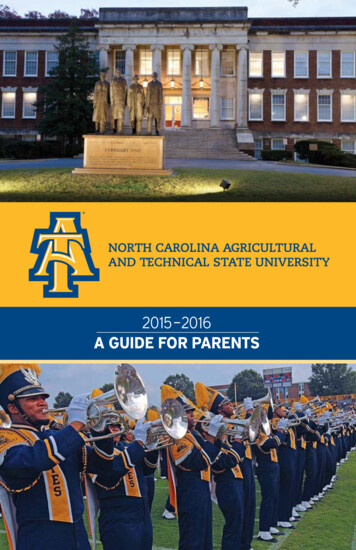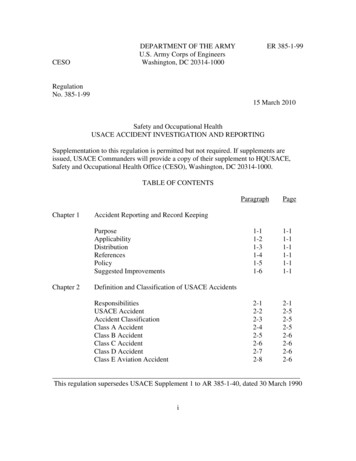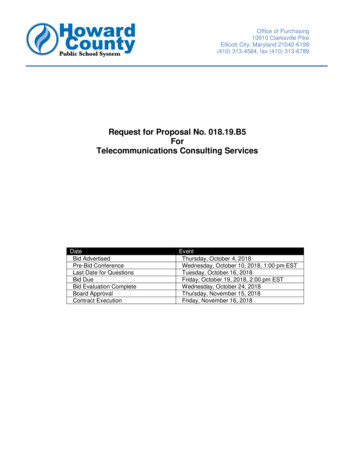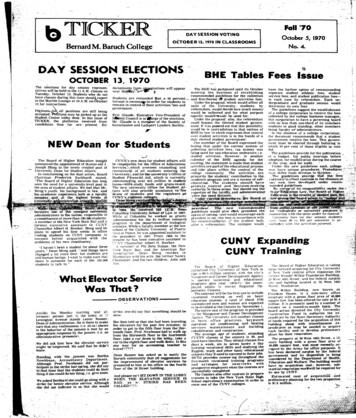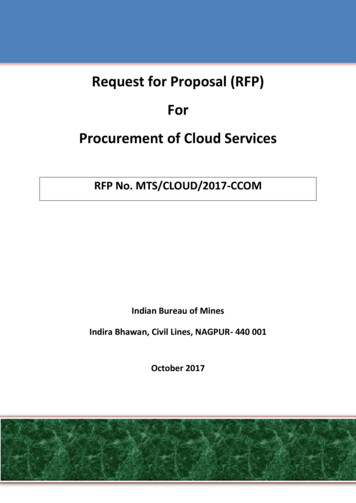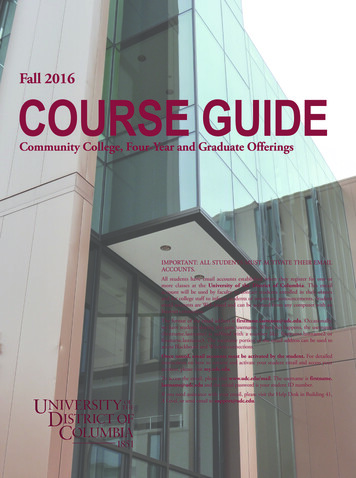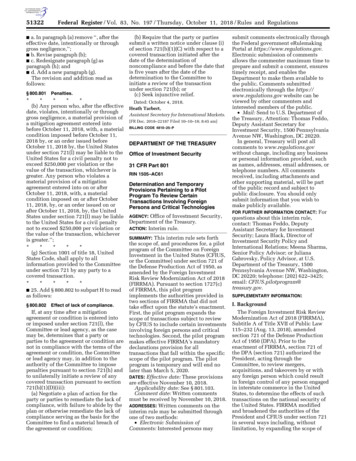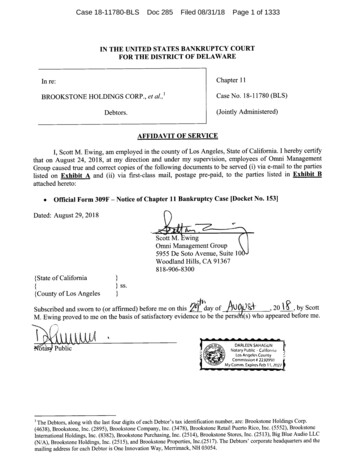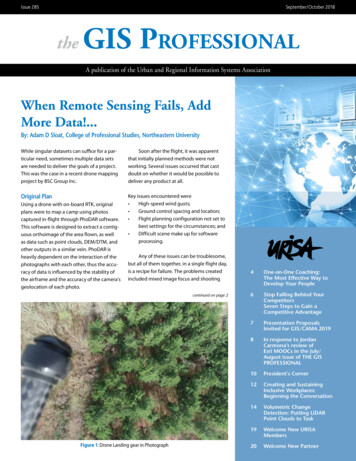
Transcription
Issue 285September/October 2018theGIS ProfessionalA publication of the Urban and Regional Information Systems AssociationWhen Remote Sensing Fails, AddMore Data!.By: Adam D Sloat, College of Professional Studies, Northeastern UniversityWhile singular datasets can suffice for a particular need, sometimes multiple data setsare needed to deliver the goals of a project.This was the case in a recent drone mappingproject by BSC Group Inc.Soon after the flight, it was apparentthat initially planned methods were notworking. Several issues occurred that castdoubt on whether it would be possible todeliver any product at all.Original PlanKey issues encountered were High-speed wind gusts; Ground control spacing and location; Flight planning configuration not set tobest settings for the circumstances; and Difficult scene make up for softwareprocessing.Using a drone with on-board RTK, originalplans were to map a camp using photoscaptured in-flight through PhoDAR software.This software is designed to extract a contiguous orthoimage of the area flown, as wellas data such as point clouds, DEM/DTM, andother outputs in a similar vein. PhoDAR isheavily dependent on the interaction of thephotographs with each other, thus the accuracy of data is influenced by the stability ofthe airframe and the accuracy of the camera’sgeolocation of each photo.Any of these issues can be troublesome,but all of them together, in a single flight day,is a recipe for failure. The problems createdincluded mixed image focus and shootingcontinued on page 2Figure 1: Drone Landing gear in Photograph4One-on-One Coaching:The Most Effective Way toDevelop Your People6Stop Falling Behind YourCompetitorsSeven Steps to Gain aCompetitive Advantage7Presentation ProposalsInvited for GIS/CAMA 20198In response to JordanCarmona’s review ofEsri MOOCs in the July/August issue of THE GISPROFESSIONAL10President’s Corner12Creating and SustainingInclusive Workplaces:Beginning the Conversation14Volumetric ChangeDetection: Putting LiDARPoint Clouds to Task19Welcome New URISAMembers20Welcome New Partner
When Remote Sensing Fails continued from page 1angle, drone gear in some photographs (Figure1), inconsistent image spacing, and a lack of solidGCPs to help overcome bad natural scene keypoints.The RTK capabilities of the drone improvedaccuracy in other projects, sometimes removingthe need for ground control in the rightconditions. With the camp location, however, alarge portion of the area was heavily woodedand even with leaf-off condition, the branchesof trees created a confusing mass of lines whichappeared different in each photograph. Withouta good selection of fixed identifiable points inthese scenes, the software returned a high rateof photo geolocation failure. Flown across fiveflights, the best result was just past 50% and theworst under 20%.A key deliverable for the project is up to dateorthoimagery, particularly of newly developedlocations. This would serve to illustrate campconditions as well as provide an up to date sourcefor digitization of detail. While hi-resolutionorthoimagery existed over the project area fromthe state of Connecticut, the temporal resolutionof data made it of minimal value for these goals.Available LiDAR data of the area (Figure 2) wassimilarly problematic.Figure 2: LiDAR Data of a Portion of the SiteAlternative PlanWhile each dataset proved insufficient on its own,data integration afforded a holistic solution.As such, the Hi-resolution orthoimagery wasgeolocated and additional coordinates extractedfor distinct features shared with the drone flightphotos. While painful at times, locating enoughdistinct features was essential to develop a robustset of 2D ground control points. The accuracy ofthe points was not survey grade, by holding themat half foot accuracy, but they did help to increasethe percentage of resolvable images.With a respectable output report for thePhoDAR software, there remained a need toQAQC the results. Analysis of the LiDAR data,with aggressive delineation settings, helpedto automate the location of as many buildingsas possible. With many cabins and other smallbuildings spread out across the camp, it wasimportant to gather a high number of cabinlocations to test the PhoDAR results, even if itresulted in false positives.The LiDAR building polygons quicklyidentified problem areas in need of additionalGCP data. While the areas looked correctgraphically, some of the building locations wereoff by as much as fifty feet (Figure 3), indicative ofFigure 3: The shift of LiDAR data with Initial OrthoimageFigure 4: Corrected Orthoimagery2
When Remote Sensing Fails continued from page 2a high general geolocation error.Once PhoDAR geolocation issues werecorrected using LiDAR as input (Figure 4),site details still needed to be digitized.Unsupervised classification was applied tothe orthoimages to help identify details inthe camp landscape difficult to locate byvisual inspection.Using both VIS and NIR bands, datawere put through a k-means routinewith some sample site data to label theresults. A mixture of shadows and groundmoisture conditions created difficulties inclear classification, but the newly classifiedimage (Figure 5) still displayed distinctpatterns useful for the study e.g., fieldstonewalls, buildings, roads, and paths. Thisenabled quick highlighting of suspecteddetail locations that could then be checkedagainst the PhoDAR output. In severalinstances, the classification helped showdata otherwise missed in a simple visualanalysis.In sum, the combined analysisafforded respectable up-to-dateorthoimagery output of the present-daysite as well as digitization of the objects onthe camp property (Figure 6). Even thoughthe problems encountered created manychallenges and headaches, they resultedin innovative alternate options for futureprojects, and a superior overall product forthe original camp project.Figure 6: Digitized Data from Orthoimagery (Portion)Definitions:LiDAR (Light Detection And Ranging):remote sensing technique for the measurement of 3D information using timedelay of reflected signals.PhoDAR: (Photogrammetric Detection AndRanging): also a remote sensing technique for the measurement of heightusing information from different acquired perspectives (structure frommotion)RTK (Real-time Kinematic): Used for satellitenavigation with enhanced precision.Figure 5: Linear Features edu3
One-on-One Coaching: The MostEffective Way to Develop YourPeopleBy: Jeffrey W. FoleyEffective one-on-one coaching is one of the most important skills agreat leader must possess. Effective coaching inspires in others aninternal drive to act ethically, without direction, to achieve goals. Effective coaching drives performance, builds competence and confidence, and ultimately enhances relationships. The best coaches helppeople find ways to make things happen as opposed to creatingexcuses why they can’t.Effective coaching also requires you to believe in yourself.You need to believe that you can have an impact in the workplace,and that you can inspire others to achieve their goals they mightnot otherwise achieve. The real question is not if you will make adifference, but what difference you will make.Respectful, transparent, and regular face-to-facecommunication between leaders and their people breaks downbarriers and builds trust. What you can see in a person’s eyes orother body language can be revealing. While technology can beeffective at times, it will never replace human contact for discoveryand inspiration.The most impactful leaders are adept listeners, and don’t allowtheir egos to become roadblocks. When egos are alive and well,listening ceases, effective coaching environments disappear, andorganizations suffer.Here are three recommendations that can help you raise the baron your ability to coach others.that wrongly promotes someone into a management position.There are three questions that can help establish this open lineof communication: What is on your mind? What can I do for you?What do you think? How am I making your life more difficult? Whenasked with the genuine interest, people respond with more honesty.Meet with your people regularly helps break down barriers.Not just in your office, but on the manufacturing floor, outside theoperating room, in the cafeteria, or the warehouse. Talk to folksoutside the work area like the jogging track, grocery store or thekid’s soccer game. The informal sessions can be wonderful enablersof opening the line of communication.1. Create a positive and open environment for communicationPeople listen to and follow leaders they trust. They engage in meaningful dialog with people they trust. They are not afraid to disagreewith people they trust. Trust provides the foundation for a positiveand open communication environment where connections betweenpeople can thrive.When people connect, they learn about each other. Theyenable understanding of cultures, individual strengths andchallenges. Knowing your people’s unique capabilities and desireshelps focus on how to help them be successful.Knowing your people also reduces the probability of promotingsomeone into a management position who does not want it or is nototherwise qualified. Not all physicians want to be managers. Not allsales people want to be sales managers. Not all technicians want tobe a shop foreman. The costs can be exorbitant to an organization2. Establish agreed upon goals and strategies to achieveMost people want to know what success looks like. They want to beclear in their goals as an individual and, if appropriate, the leader ofa team. Well-defined, measurable, relevant goals on paper help people gain clarity on success for them. Assigning responsibility withauthority helps inspire an individual’s commitment to be successful.Success also includes how to reach their goals. Strategies aredeveloped and agreed upon by the manager and team member sothat both understand each other’s roles. The probability of successincreases dramatically when strategies and accountabilities are welldefined.3. Enforce accountability by assessing performanceThere are many and significant consequences when people are notheld accountable for achieving goals or otherwise performing tostandard. Integrity disappears. Discipline erodes. Morale evaporates. Leaders are not taken seriously. Problem employees becomeThe most impactful leaders are adept listeners, and don’tallow their egos to become roadblocks.4
One-on-One continued from page 5an underperformer are doing a great disservice to their institution.All too often, good people serving in leadership positions fear thetask of confrontation. They hope, magically, that something willhappen which will turn the underperformer around and all will bewell in the end. Hope is not a strategy; the magic seldom happens.Your goal as a leader and coach is to inspire a willingness to succeed.When coaching, it is often easier to criticize and find fault. Thinkbefore you speak—find ways to praise.Fourth, as the manager, seek suggestions for how you canbe a more effective leader for them. This question can change thedynamic of the coaching session and can provide powerful feedbackfor the manager in his or her quest to be the best they can be. Doingso will enhance their trust in you and help build confidence in theirown capabilities.Remember, effective one-on-one coaching can be the catalystfor attracting and retaining the best people, and that will ultimatelyhelp your organization to unprecedented results.a cancer in the organization. The best people leave. Results are notachieved.Effective coaching demands assessment of performance.Without this assessment, no system of accountability will beachieved. If the senior leader does not hold his or her executive teamaccountable, subordinate leaders are likely to think “Why should I?”Consistent, regularly scheduled coaching sessions with yourpeople are the key to ensuring effective follow-up assessments tocelebrate successes and identify areas to improve.SummaryCoaching session agendas will vary based on a variety of conditions.A good place to start is outlined below.First, review the individual goals and those of the organization.Ensure alignment of both to clarify where the individual iscontributing to the mission of the organization.Second, discuss what is going well. Where do both the coachand the individual agree on successes? Provide positive recognitionfor achievements where important.Third, discuss the challenges or areas for improvement.Underwrite honest mistakes in the pursuit of excellence so peoplecan learn. Determine how you as the manager can help. Gain a clearunderstanding of the shortfall in the individual’s ability and desireto achieve the goal and what resources or assistance the individualneeds to be successful. When unsatisfactory performance occurs,managers must address it. Leaders who never take action to removeABOUT THE AUTHOR:Jeff Foley is a recognized speaker, executive leadership coach, and author of Rules and Tools for Leaders. He is a West Point graduate and retired as a Brigadier General having served thirty-two years in the Army.Drawing on his unique military experience, Jeff uses his singular insightto build better leaders. For more information on Jeff Foley, visit www.loralmountain.com.Thanks to the URISA Board members whose three-year terms areconcluding at the end of GIS-Pro & CalGIS 2018!Your dedication to the organization has been nothing short of amazing!Immediate PastPresident:Tripp Corbin, GISPeGIS Associates, Inc,Dacula, GeorgiaTreasurer:Stephen Berry, GISPClark County Consortiumfor GISWinchester,KentuckyKeri Brennan, GISP*Michael Baker InternationalIndianapolis, Indiana* Keri is continuing on with another term on the Board. She will be President-Elect.5Corey Halford, GISPCalgary, Alberta Canada
Stop Falling Behind Your CompetitorsSeven Steps to Gain a CompetitiveAdvantageBy: Brad WolffDoesn’t it seem that business is more competitive and difficult thanit used to be? ABC, Inc. experienced this challenging business atmosphere firsthand. A building materials manufacturer that previouslydominated their marketplace, ABC suffered staggering losses in theprevious fiscal year. It became blindingly apparent that what hadworked in the past was no longer effective, and the company president had no idea how to fix things. It was time to use proven techniques for achieving a competitive advantage.ABC engaged a firm that identified the root causes oftheir problems. After two years, sales and profits dramaticallyincreased—even with the same leaders. The results came from aseven-step process based on sound principles that put a focus onleveraging their internal talent. If you find your business fallingbehind, you can follow ABC, Inc.’s lead by putting these seven stepsinto practice.of innate talents to maximize productivity and effectiveness. Mostperformance issues that managers complain about relate to one ormore of the above. These are fundamental character traits of success.3. Aligning employees with the mission and vision of theorganizationHuman beings have an innate need for meaning and purpose inwhat they do. This means that they care about how their effortsaffect the world outside themselves—people, the environment,animals, etc. For example, take assembly line workers that produceincubators for premature babies. In one scenario the workers areonly told to mechanically perform the prescribed duties. In the other scenario they are crystal clear about the importance the quality oftheir work has on the survival of infants. Which workers do you thinkare more motivated? Engagement and performance are directly affected by people’s connection to the outcomes of their work.1. Employee alignmentWhen a significant percentage of duties performed by employeesdon’t fit their innate characteristics or core nature, they won’t perform well. For example, people low in detail orientation doing workthat requires high detail. Training and development, managementencouragement and other well-intended efforts will not fix alignment issues. As Peter Drucker said, “A manager’s task is to make thestrengths of people effective and their weaknesses irrelevant.”4. Aligning employees with the culture and values of theorganizationPeople need to feel that they fit in with their social groups. Employees who are significantly out of sync with an organization’s cultureand values will never make their highest contribution. Having perfect alignment is the point, since diversity of thought and behaviorallow a culture to adapt and thrive. However, significant misalignments are damaging. It’s also important for leaders to considerwhether they should change their culture. Examples of this wouldinclude a culture that they know is toxic and when there’s shrinkingpopulation of workers who fit the current culture. In both cases,without the ability to attract and retain needed talent, organizationswill fail.2. Creating a competitive advantage through a culture ofpersonal growth and developmentIn truth, personal growth results in professional growth. It results ina greater capacity to handle life challenges, accomplish long-termgoals and work well with others. Personal growth and developmentincludes an increased awareness of self and others, the ability tomanage one’s ego, ability to manage emotions and development5. Aligning roles and responsibilities with organization’sstrategies and goalsIn today’s environment, organizational goals and strategies mustchange to adapt. Frequently, roles and supporting job duties don’tadequately change to align with these shifts. When this occurs,some or much of employee work efforts are out of alignment andcan impair the ability to achieve the desired outcomes. For example,a company changes strategy to shift most customer communications from telephone to online, yet the employees’ duties and training continue to focus on telephone communications.6
Stop Falling Behind continued from page 76. Assessing personal and professional weaknesses, startingfrom the topAt the end of the day, leaders are simply making choices thatdefine the present and future of themselves and their organizations.There’s nothing magical about the most effective leaders. They’rejust making more effective choices. These choices encompass howthey decide to see the world, their openness to challenge theirbeliefs and their willingness to experiment with innovative ideasthat can capture breakthrough advantages. Equally importantchoices include their willingness to objectively look at themselvesand take actions to grow in areas. They choose to become a greater,more effective version of themselves. They know that what theydemonstrate (not what they say) is what has the greatest impact onthe entire organization. As a leader, the question is, what choicesare you going to make?Weaknesses are the negative side of strengths. It’s impossible tohave a strength without its vulnerable side. We’ve been taught tohide or deny our weaknesses despite them being obvious to others.Our ego’s impulse to protect our self-image is normal but counterproductive. It hinders our true potential from being realized— a lossto the organization and ourselves. When leaders openly and honestly acknowledge “challenge areas,” this sets the example for others. The organization opens the door to growth and development.7. Committing to work on the personal and professionalchallenges discovered in the assessment processStudies on human potential and positive change demonstrate thatself-awareness is the first step—but it’s not the last. Committing totake steps (starting with baby steps) and taking them allows for thedevelopment of positive habits that create lasting positive change.Deliberate change intended to meet the needs of your environmentcreates a flexible, adaptive organization—ne that is poised to thrivedespite the torrent of unpredictable/unwanted change that definesyour world. Thriving in an unpredictable world is about you. Yourwillingness to acknowledge change that you don’t like, openlydiscuss it and consistently take the actions required to adapt andemerge stronger.ABOUT THE AUTHOR:Brad Wolff specializes in workforce and personal optimization. He’s aspeaker and author of, People Problems? How to Create People Solutions for a Competitive Advantage. As the managing partner for Atlanta-based PeopleMax, Brad specializes in helping companies maximizethe potential and results of their people to make more money with lessstress. His passion is empowering people to create the business successthey desire, in a deep and lasting way. For more information on BradWolff, please visit: www.PeopleMaximizers.com.Presentation Proposals Invited for GIS/CAMA 2019Submit a presentation proposal for GIS/CAMA 2019 in Portland: Presentation proposals are due on or by October 15, 2018For complete details and online submission forms, click here.Here’s what some of this year’s attendees in Houston (March2018) had to say: It is far better than any local conference I have attended. Goto this conference to see what a “real” conference is like. Best conference to attend all year! Great that it is both GIS &CAMA and so relevant! It is interesting to see what others have done and maybe wedon’t have to reinvent the wheel. I’ve met many of the best professional contacts at GIS/CAMA. It’s great to share ideas & inspiration with others who“get what you do.” It’s a great user-led conference for applicable solutions. GIS/CAMA is a must-attend for any assessment officethat is maximizing its budgetary resources by leveragingtechnology to achieve the proper balance of people, time,and money.7
In response to Jordan Carmona’s reviewof Esri MOOCs in the July/August issueof THE GIS PROFESSIONAL2018 Third and Fourth Quarter MOOCsDear Jordan, Thanks so much for your entertaining and valuable review of thetwo recent Esri MOOCs you joined. We could not be more pleasedwith your clever and effective writing or your honest and accuratecomments. We did want to share some reactions to a few of the issues you raised.You enrolled in and both Cartography. and The LocationAdvantage at the same time. While individuals with lots of timeon their hands may want to tackle more than one MOOC at a time,anyone with full time commitments may want to stick to one attime (whether it’s an Esri MOOC or one from other provider or anonline course in a degree or certificate program). We are reviewingthe suggested weekly time requirements for our MOOCs; we agreethat 2-3 hours is perhaps best described as a minimum commitment.By the way, we “pair” our MOOCs based not on how they maycomplement one another, but on something sadly practical: theavailability of our MOOC team members.You noted that course dialogs were mostly unidirectional,from instructor to student. We are working hard to include moreinteraction into our MOOCs. The course forums are open 24/7 andwe are pleased to hear from a good number of students that theconversations hosted there were among the most valuable parts ofthe course. We are tweaking the forum interface to allow for bettersearching and tagging; this becomes especially important when18,000 students are participating in a course offering, as was thecase with Cartography. this past spring.You identified a number of differences between The LocationAdvantage, our second MOOC from 2015, and Cartography., ourfifth MOOC from 2018. The MOOC team has learned quite a lot inthe intervening years and incorporated new ideas, techniques,and tapped other Esri teams. Much credit goes to the Esri CreativeLab staff, which directed, produced and edited the short films yousaw in Cartography. We didn’t have access to that sort of set andtalent back in 2015. We are currently revisiting our early MOOCsto determine how to update them. In September are beginningproduction on an update to our first MOOC: we are developingseason two of Going Places with Spatial Analysis. Do-It-Yourself Geo Apps: Sept 5 – Oct 3, 2018 (four weeks; allcontent opens on the first day)John Shramek, who helped develop and has been teaching TheLocation Advantage MOOC, will teach this offering. While much ofthe course has not changed and focuses on building apps withoutany programming, John enhanced the exercises to introducestudents to Survey 123 and Operations Dashboard. http://arcg.is/2kqHWz6Cartography.: Sept 5 – Oct 17, 2018 (six weeks; new contentopens each week)This is the second offering of the course from Ken Field, Edie Punt,John Nelson, Wes Jones and Nathan Shephard. Student feedbacksuggests this course, which highlights ArcGIS Pro’s cartographicfeatures, is also a great introduction to the software. http://arcg.is/2teM7VNEarth Imagery at Work: Oct 31 - December 12, 2018 (sixweeks; new content opens each week)Kevin Butler leads students through scenarios highlighting howimagery is used in a variety of disciplines including disasterresponse, agriculture and commercial business. Students are oftensurprised at how many imagery exploitation tools are available inArcGIS Online and ArcGIS Pro. http://arcg.is/2jMPFoQ2019 First and Second Quarter MOOCs Going Places with Spatial Analysis February 6 - March 21, 2019(six weeks; new content opens each week)Linda Beale, the very first Esri MOOC instructor returns for “SeasonTwo” of this spatial analysis course. Students will use Insights forArcGIS and tackle new hands-on exercises. http://arcg.is/2kUAeRiDo-It-Yourself Geo Apps: February 6 - March 6, 2019 (four weeks;all content opens on the first day)Cartography.: April 10 - May 23, 2019 (six weeks; new contentopens each week)Earth Imagery at Work: April 10 - May 23, 2019 (six weeks; newcontent opens each week)We appreciate you sharing your Esri MOOC experience withothers and look forward to your next review, article or column ongeospatial topics.We hope you’ll join us for another Esri MOOC soon! Here’swhat’s coming up:David DiBiase, Director of Education, EsriAdena Schutzberg, MOOC Program Manager, Esri8
GIS-Pro &CalGIS 2018October 9-12, 2018Palm Springs, CaliforniaFull ProgramDetailsGISP Certification: As always, this event earnsample Education points toward GISP initial certificationand renewal.Featured keynote speaker– Jack DangermondBe sure to check the box onthe registration form or email URISA ifyou are interested in taking advantageof onsite childcare services during theevent. #GISBabies #FamilyFriendlyAICP-CM Approved Credits: The Palm Springs programwas approved for 90.5 AICP-CM credits! For thebreakdown, click here or download the PDF summary.We are hosting a silent auction to supportfundraising for URISA’s GISCorps ! Getready to bid! If you have an items(s) tocontribute to the auction, please emailURISA.In addition to valuable meet-ups andnetworking events, URISA’s VanguardCabinet of Young Professionals issponsoring K-12 and University studentcompetitions and a Young Professionalcompetition! More here.Check out this Story Map of Palm Springs attractions. You might want to plan an extended visit in October!9
President’s CornerTeresa Townsend, AICPLooking Back & Moving Forward . As I sit down to write my final president’s column, let’s take sometime to celebrate and reflect on URISA’s progress and tremendousstrides over the past year and keep our focus in moving forward into2019. LOOKING BACKHighlights from 2018 STRATEGIC & ACTION PLAN Thinking and acting in a strategic direction was foundational for URISA over the past year and the current Strategic Plan was the guidingdocument for all.The 2017-2018 Strategic Plan was approved on October 26,2017 (revised/updated in Feb. 2018) and includes goals & objectivesand an Action Plan effective from GIS-Pro 2017 to GIS-Pro 2018.Goals and objectives were defined in the current Strategic Planto reflect URISA’s mission and 3 Key Strategic Goals. All goals andobjectives include actions which are integrated into the work ofURISA committees, task forces and organizational initiatives for acomprehensive and unified approach. URISA and its Four California Chapters Urge Support andContinued Operation and Funding of California’s GeodeticControl System- April 2018URISA signs onto Census Project stakeholder letters tothe House and Senate expressing concern regarding citizenshipquestion- April 2018URISA signs onto Census Project stakeholder letter expressingsupport for sufficient funding for the U.S. Census Bureau and, inparticular, 2020 Census activities in Fiscal Year (FY) 2019.- May2018URISA Urges Support for the National Agriculture ImageryProgram - May 2018Special Interest Groups (SIGs)URISA has recently approved and re-introduced Special InterestGroups (SIGs) to create a forum where a group of individuals can focus on specific issues or interests in the GIS industry. Specifically, anAddressing and Land Records SIG is expected to be starting up soonas well as others in the near future! This is a perfect avenue for members to engage in topics ofkeen interest to them.LEADERSHIP ACADEMY:TRAINING & RESOURCESGIS Leadership AcademyDue to the high volume ofparticipation and interest,the GIS Leadership Academy was expanded this year and continuesto gain momentum.In 2018, 161 graduates (a 66% increase from 2017) from all overthe world participated in the URISA GIS Leadership Academy. Planto attend the next one in Austin, Texas on December 3-7, 2018 or signup for 2019!ADVOCACYChapter SupportPolicy Advisory Committee (PAC) provided requested outreach andsupport for several chapters on GIS and industry-specific policy actions.GIS Salary SurveyThe 2017 GIS Salary Survey was published this year! URISA’s GIS Salary Survey is an ideal resource for both job seekers and those whohire GIS staff. As in the past, an Executive Summary is available forFREE and a comprehensive analysis of the results is available for purchase.Boundaries of PracticeThe newly published paper, “Boundaries of Practice” reviews thecurrent definition of professional
listening ceases, effective coaching environments disappear, and organizations suffer. Here are three recommendations that can help you raise the bar on your ability to coach others. 1. Create a positive and open environment for communication People listen to and follow leaders they trust. They engage in mean-ingful dialog with people they trust.
